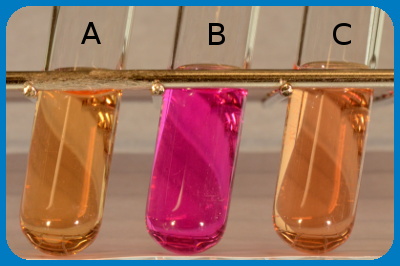Urease test
The figure shows the result of an urease test, where tube A is a negative control. Tube B contains, Proteus sp. and tube C contains Escherichia coli. Note that a pH change has occured in tube B because Proteus spp. are urease positive. Image:Karl-Erik Johansson (BVF, SLU) and Lise-Lotte Fernström (BVF, SLU).
General
Some bacteria have the enzyme urease, which in the presence of H2O converts urea (=carbamide) to NH3 (ammonia) and CO2 (carbondioxide), which forms ammonium carbonate in the presence of water. See chemical reaction formula. MethodBy growing the bacteria in urease medium containing a pH indicator, it can be determined if the bacteria express urease. If the bacteria have an urease, urea will be converted to ammonium carbonate and the medium will turn alcaline. Thus, the colour will change to red (cerise). Urease medium:
ApplicationsThe urease test can be used to distinguish between E. coli, which is urease negative, from Proteus spp., which are urease positive. Updated: 2017-03-31. |

